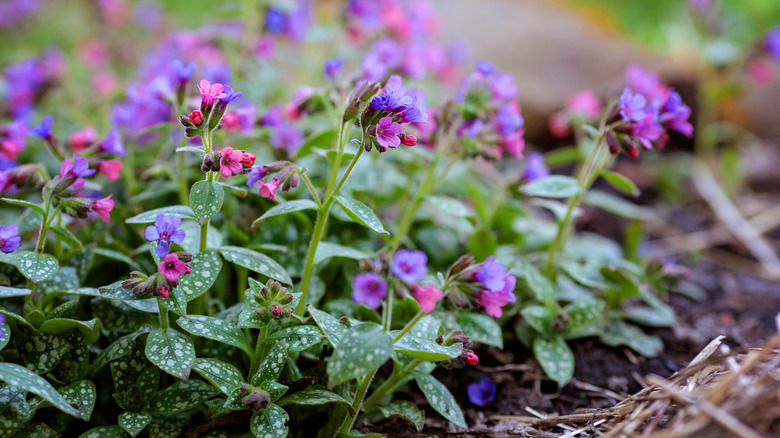The Silver-Speckled Ground Cover That Will Add Stunning Flowers To A Shady Yard
Only this adorable plant could get away with a name as unfortunate as lungwort (Pulmonaria). With fuzzy, spotted leaves shaped like elongated hearts and flowers that change color over time, lungwort will pretty up your shady yard like no other. This plant was sought-out as a remedy for lung ailments in the 16th and 17th century because its leaves resembled a diseased lung. The name stuck, but it also goes by "spotted dog" and "Jerusalem cowslip," among others.
Forego a lawn for this no-mow substitute around your trees. Among the ground cover plants that love shade, lungwort stands out with long-lasting beauty, charming flowers, and ease of care. Plant some pulmonaria under your trees for a lush carpet that takes little work once it's established. Flowers emerge in early spring, then step aside so the leaves attract all the attention. Lungwort stays lovely for several seasons and fills low-sun spots with color and life.
Why you'll love lungwort
We all want our yard to please the eye without lots of work, and here's where lungwort wins the prize. Pulmonaria will show you why sometimes you should grow ground cover plants instead of grass in your yard.
If color-morphing blossoms weren't enough, lungwort flowers emerge on one plant at different times. This results in staggered color changing for the blossoms. Among the same cluster of leaves, you may see blue, white, pink, or purple florets. In some of the warmer corners of the US, lungwort leaves stay green for most of the year and can bloom in late winter.
You'll put a lot less mileage on your lawn mower once you set up an easy-care bed of lungwort. Not only will it save you some trimming time, it's both deer and rabbit resistantand attracts few pests. It doesn't require much fertilizer, and the fact that it's a lure for hummingbirds is the icing on the cake.
Planting and caring for lungwort
If your yard has partial shade, well-drained nutritious soil, and isn't either too wet or too dry, your area is probably suited for lungwort. This cold-tolerant plant grows well in zones 3 to 8, but it doesn't handle drought well. It needs cool, moist soil and regular watering. Lungwort can handle up to six hours of full sunlight but does best in partial shade with as little as two hours of direct sun.
In order to make the most of your new lungwort plants, set them up for success in soil that's full of organic matter. If your chosen spot is lacking in soil health, give it a leg up with amendments like compost or aged manure. During long stretches without much rain, water the lungwort thoroughly every week or week and a half, soaking the soil well up to about 12 inches deep.
Once your lungwort patch is well-established, you can expect the plants to grow as tall as nine to 18 inches and up to 32 inches wide, and you can divide the plants to propagate them. Experts at Clemson University recommend doing this in the fall. Here's what you need to know about dividing perennials to build your confidence for this task.


